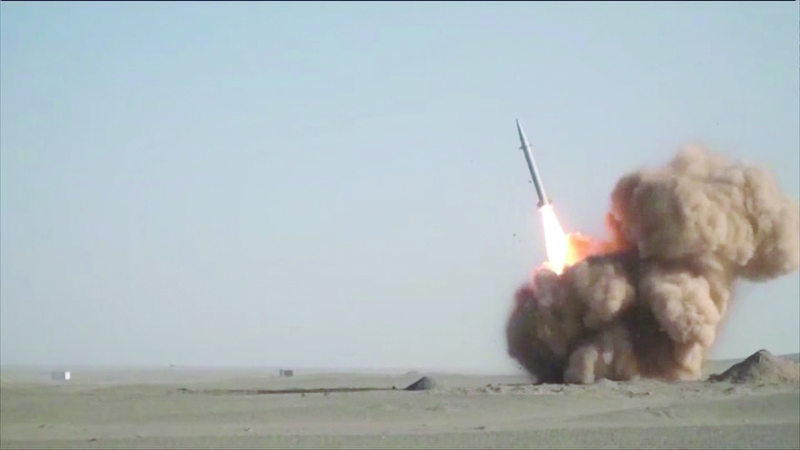
TEHRAN: Iran "successfully" launched a satellite into space yesterday but it fell short of reaching orbit, a defense ministry spokesman said on state television. Telecommunications Minister Mohammad Javad Azari Jahromi admitted in a tweet that the launch "failed", adding: "But We're UNSTOPPABLE! We have more Upcoming Great Iranian Satellites!"
The satellite had been launched at 7:15 pm (1545 GMT) before it went "90 percent of the way", reaching an altitude of 540 km, said Ahmad Hosseini, spokesman for the defense ministry's space unit. "The Simorgh (rocket) successfully propelled the Zafar satellite into space but the carrier did not reach the required speed to put the satellite into the intended orbit," he told state television.
"Unfortunately, in the final moments the carrier did not reach the required speed. God willing with improvements made in future launches this part of the mission will be done as well," he added. "We achieved most of the goals we had and data has been acquired, and in the near future, by analyzing the data, we will take the next steps."
The satellite, which Iran says was to be used for scientific observation, is part of a program that Tehran's arch enemy Washington has described as a "provocation". The arch foes have appeared to be on the brink of an all-out confrontation twice in the past seven months.
Long-standing acrimony between Tehran and Washington was exacerbated in 2018 when US President Donald Trump unilaterally withdrew from a deal that froze Iran's nuclear program, before and issuing new demands that Tehran curtail its development of ballistic missiles. Washington has also raised concerns in the past about Tehran's satellite program, saying the launch of a carrier rocket in January 2019 amounted to a violation of limits on its ballistic missiles.
Iran maintains it has no intention of acquiring nuclear weapons, and says its aerospace activities are peaceful and comply with a UN Security Council resolution. Jahromi, had announced the impending launch by tweeting: "Beginning countdown to launch #Zafar_Satellite in the next few hours… In the Name of God."
On Feb 1, the head of Iran's space agency said the 113-kg Zafar - "Victory" in Farsi - would be launched into orbit 530 km above Earth by a Simorgh (Phoenix) rocket. Its "primary mission" would be to collect imagery, Morteza Berari told AFP, adding that Iran needed such data to study earthquakes, deal with a range of natural disasters and develop its agriculture. The Zafar was designed to remain operational for "more than 18 months", he added. While the Islamic republic's satellite program has sparked concern among some Western countries, Berari said Iran supported the "peaceful use of outer space".
Iran also unveiled yesterday a new a short-range ballistic missile and its "new generation" of engines designed to put satellites into space. The Guards' Sepahnews website said the Raad-500 missile was equipped with new Zoheir engines made of composite materials lighter than on earlier steel models. It also unveiled Salman engines made of the same materials but with a "movable nozzle" for the delivery of satellites into space. The Raad was "a new generation missile that has half the weight of a Fateh-110 missile but with 200 km more range," it added. The Fateh-110 is a ballistic ground-to-ground missile first unveiled in 2002. Its latest generation has a range of 300 km.
Islamic Revolutionary Guard Corps commander Major General Hossein Salami unveiled the missile and engines alongside IRGC aerospace chief Brigadier General Amirali Hajizadeh. "The complicated achievements on the bleeding edge of global technology that were unveiled today are our key to entering space," Salami said. Salami noted the movable nozzle on the new engine allowed "maneuverability beyond the atmosphere" and amounted to a "leap in modern missile technology". The new technologies that made the missiles "cheaper, lighter, faster and more precise" could be applied to all of Iran's missile classes, he added.
In Jan 2019, Tehran announced that its Payam - "Message" in Farsi - satellite had failed to reach orbit, after authorities said they launched it to collect data on the environment in Iran. The United States said the launch of the carrier rocket was a violation of a 2015 UN Security Council resolution endorsing the international accord on curbing Tehran's nuclear program. Resolution 2231 called on Iran to refrain from any activity related to ballistic missiles capable of delivering nuclear weapons.
Tehran confirmed in September that an explosion occurred at one of its satellite launch pads due to a technical fault, and slammed Trump for "gleefully" tweeting about it at the time. Trump said the US had nothing to do with what he called a "catastrophic accident" at Semnan Space Centre in a tweet alongside a high-resolution picture pointing to apparent damage at the site.
The Zafar's launch came days before the 41th anniversary of the Islamic Revolution and crucial parliamentary elections in Iran. It also comes at a time of heightened tensions between Tehran and Washington, after a January 3 US drone strike killed top Iranian general Qasem Soleimani in Baghdad. Iran retaliated days later by firing a wave of missiles at American troops stationed in Iraq. Its defense forces had been braced for US retaliation when they accidentally shot down a Ukraine International Airlines flight a few minutes after take-off from Tehran on Jan 8.
Iran says its Internet services have faced cyber attacks for the past two days, without elaborating on the source of the attack or the likely motives. Replying to a citizen's tweet that asked what if the Zafar rocket fails like its predecessor, Jahromi said "we will try again". Iran's on-off space program unsettles some Western nations as the technology used in space-bound rockets can also be used in ballistic missiles. The Islamic republic fired its first satellite into orbit in Feb 2009, and it went on to successfully launch satellites in June 2011, Feb 2012 and Feb 2015. It has also sent monkeys, a turtle, mouse and worms into space.










